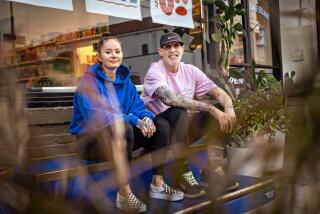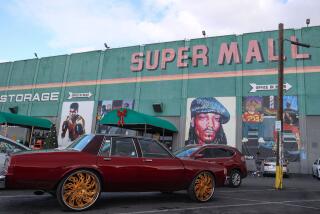Free-lunch foragers

For lunch in her modest apartment, Madeline Nelson tossed a salad made with shaved carrots and lettuce she dug out of a Whole Foods dumpster. She flavored the dressing with miso powder she found in a trash bag on a curb in Chinatown. She baked bread made with yeast plucked from the garbage of a Middle Eastern grocery store.
Nelson is a former corporate executive who can afford to dine at four-star restaurants. But she prefers turning garbage into gourmet meals without spending a cent.
On this afternoon, she thawed a slab of pate that she found three days before its expiration date in a dumpster outside a health food store. She made buttery chicken soup from another health food store’s hot buffet leftovers, which she salvaged before they were tossed into the garbage.
Nelson, 51, once earned a six-figure income as director of communications at Barnes and Noble. Tired of representing a multimillion dollar company, she quit in 2005 and became a “freegan” -- the word combining “vegan” and “free” -- a growing subculture of people who have reduced their spending habits and live off consumer waste. Though many of its pioneers are vegans, people who neither eat nor use any animal-based products, the concept has caught on with Nelson and other meat-eaters who do not want to depend on businesses that they believe waste resources, harm the environment or allow unfair labor practices.
“We’re doing something that is really socially unacceptable,” Nelson said. “Not everyone is going to do it, but we hope it leads people to push their own limits and quit spending.”
Nelson used to spend more than $100,000 a year for her food, clothes, books, transportation and a mortgage on a two-bedroom co-op in Greenwich Village. Now, she lives off savings, volunteers instead of works, and forages for groceries.
She garnishes her salad with tangy weeds picked from neighbors’ yards. She freezes bagels and soup from the trash to make them last longer. She sold her co-op and bought a one-bedroom apartment in Flatbush, Brooklyn, about an hour from Manhattan by bike. Her annual expenditures now total about $25,000.
“I used to have 40 work blouses,” said Nelson, sipping hot tea with mint leaves and stevia, a sweet plant she picked from a community garden. She shook her head in shame. “Forty tops, just for work.”
Freeganism was born out of environmental justice and anti-globalization movements dating to the 1980s. The concept was inspired in part by groups like “Food Not Bombs,” an international organization that feeds the homeless with surplus food that’s often donated by businesses.
Freegans are often college-educated people from middle-class families.
Adam Weissman, whose New York group Freegan.info has been around for about four years, lives with his father, a pediatrician, and mother, a teacher. The 29-year-old is unemployed by choice, taking care of his elderly grandparents daily and working odd jobs when he needs to. The rest of his time is spent furthering the freegan cause, he said, which is “about opting out of capitalism in any way that we can.”
Freegans troll curbsides for discarded clothes and ratty or broken furniture, which they repair to furnish their homes. They trade goods at flea markets. Some live as squatters in abandoned buildings, or in low-rent apartments on the edges of the city, or with family and friends.
In recent years, Internet sites like Meetup.com have posted announcements for trash tours in Seattle, Houston and Los Angeles and throughout England. Some teach people how to dumpster-dive for food, increasing the movement’s popularity. At least 14,000 have taken the trash tour for groceries over the last two years in New York. Another site, Freegankitchen.com, offers lessons for cooking meals from food found in dumpsters, such as spaghetti squash salad.
Though recycling clothes and furniture doesn’t strike most people as unusual, combing through heaps of trash for food can be unthinkable to many.
One recent night, Weissman and Nelson led a trash tour through New York for about 40 experienced and first-time diggers, including college students, a high school teacher, a taxi driver and a former investment banker. One veteran handed out plastic gloves.
An employee at D’Agostino’s supermarket in Midtown Manhattan had carried out the garbage minutes earlier. The clear plastic bags lining the gum-stained sidewalk bulged with bruised peaches, discolored eggplants, day-old poppy seed bagels and imitation crabmeat.
Careful not to rip the bags and risk angering store managers by creating a mess, some unknotted the ties and sifted through the garbage with bare hands. The bittersweet scent of cilantro, bananas and bread drifted into the air.
Two women who worked next door at a nail salon came outside and stared. A few first-time tour-takers stood away from the group, looking self-conscious.
“We encourage people who have never opened a bag before, just try it,” Nelson told the group. “Go ahead.”
A few began filling backpacks and plastic bags with food that looked fresh enough to eat: heads of lettuce, tubs of party dip, baby arugula salad mix, avocados, shiny red and green apples, corn on the cob -- mere scraps in the estimated 50 million pounds of food that New York throws away each year, including at least 20 million pounds that go to the poor.
“Whoa, someone found the soy milk!” said Cindy Rosin, 31, a freelance graphics designer. “Good find.”
One person pulled a bag of Purina dog chow from the pile. Another found a bunch of grapes.
Two men in dark dress slacks, button down shirts and shiny shoes approached the trash tourists. “Pardon me, what is this?” one asked. “Vegetable justice?”
“It’s over-consumerism,” said Gracie Janove, 19, an anthropology student with a crescent moon pendant hanging around her neck. Janove, who participated in her first dumpster dive during a trip to France, frequently searches the trash of New York bakeries for pastries and the garbage of grocery stores for fruit.
The two men walked away, laughing.
D’Agostino’s, Trader Joe’s and Whole Foods -- freegans’ most popular dumpster diving sites -- donate edible food to agencies that prepare it for the poor, according to their spokespeople. But freegans and food experts say a large amount of edible food still gets thrown away. Smaller businesses don’t always have agreements with food banks, they say, or they have not taken time to donate.
“We have found canned goods, completely wrapped pastas,” said Nelson, who recently salvaged piles of parsley, lettuce, onions and a potted plant from a Whole Foods’ garbage.
Sometimes grocery stores don’t sell food because there was an error in the processing, and though the product may be edible, it is the wrong color or shape, said Beth Osborne Daponte, a senior research scholar at the Yale University Institution for Social and Policy Studies who served on the Hunger in America 2006 task force.
The Environmental Protection Agency estimates that Americans create 245 million tons of waste a years, about 12% of it food. Much of the food that stores throw out is still edible at the time of its expiration date.
“We shouldn’t be wasting as much as we do,” Daponte said. But, she added, “to go dumpster diving, you also have to be willing to take the risk. Some of the food might be great. Some might be contaminated.”
Supermarket officials say food found in their trash should not be eaten.
“Food items are disposed of because they are inedible or not otherwise safe to donate,” said Ashley Hawkins, a spokeswoman for Whole Foods.
The store’s guidelines about what is edible, Weissman said, may be unrealistic, adding that at home, people wouldn’t throw away a banana with a few brown spots.
As Nelson and Weissman helped guide the scavengers to their next stop on the trash tour, a D’Agostino’s employee brought out a big bag of doughy, plump, sweet-smelling bagels.
The experienced freegans glanced at the bag and kept walking. Instead they led the group across the street to Daniel’s Bagels, voted one of the best bagel shops in New York by one online site.
“We’re picky freegans,” said Deirdre Rennert, who would not reveal her place of work because of the stigma attached to living off dumpster groceries. She once took home a salmon carcass from D’Agostino’s trash and made ceviche, and admitted she was somewhat surprised she did not get sick.
Daniel’s had closed at 9 p.m. and its storefront was lined with black trash bags. The group sniffed and squeezed the bags. They opened the ones that felt soft and smelled of bread fresh from the oven. They discovered pounds of bagels: onion, pumpernickel, cinnamon raisin, sesame, sourdough.
“Usually you will find a bag that has got the coffee remains with the bagels,” Rosin told the diggers. “If they are nice, they will separate them.”
Nelson scooped up two bags of bagels to freeze for later.
A few doors down, on the outdoor patio of a swanky restaurant, people sipped glasses of wine over half-eaten platters of pasta and salad, mostly ignoring the trash diggers, waiting for busboys to take away their leftover food.
Since she upended her lifestyle, Nelson has learned how much she can live without. She still buys toilet paper and food for her two cats. She hasn’t bought clothes in three years. Nor has she set foot in a supermarket to purchase eggs, vegetables, fruit, bread or coffee.
Sitting in her hardwood-floor apartment furnished mostly with remnants of her former life -- a sofa with slightly torn fabric, an elaborate collection of books -- she wore a plain T-shirt and faded dark jeans cut off below the knee.
The place is decorated with a few items she found in the trash: a chair, CD rack, rug and headboard in her bedroom.
Her cupboards were full of food she did not pay for: cake mix, turkey gravy, curry mix, sweet rice. The freezer contained oatmeal bread, lime and cucumber sorbet, tomato basil soup and bagels. Everything was retrieved from the trash.
“Just because it’s two or three days past its pull date, it’s not like it’s Cinderella’s coach and it’s going to turn into a pumpkin at midnight,” she said.
Last year, Nelson asked her family if she could make Thanksgiving dinner out of foraged food. They found the idea odd at first, but agreed, and ended up enjoying an elaborate feast.
Nelson used to love browsing department stores or buying new books or shoes.
Now she finds satisfaction recovering 20 rosemary-seasoned roasted chickens from a dumpster outside of the Gourmet Garage, or sharing conversation over a lunch made from garbage.
She has never been happier.
More to Read
Start your day right
Sign up for Essential California for news, features and recommendations from the L.A. Times and beyond in your inbox six days a week.
You may occasionally receive promotional content from the Los Angeles Times.






